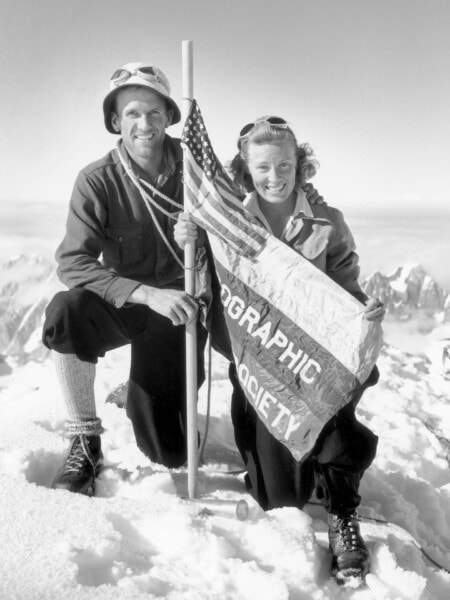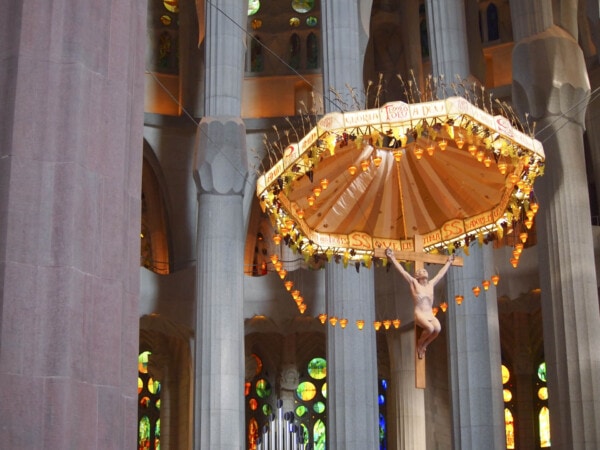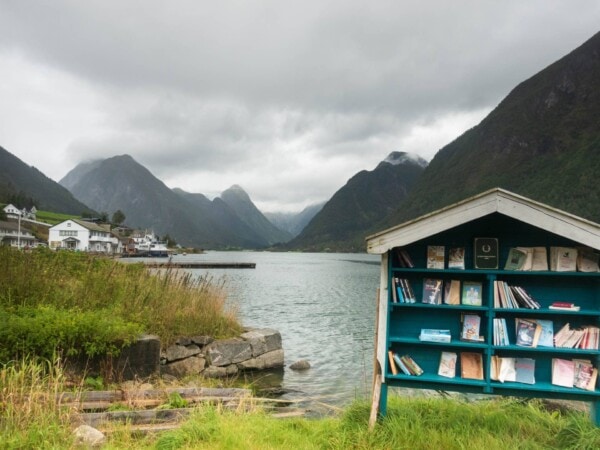I stood on the roof of North America, the summit of Mount McKinley. I was very cold. The wind was gusting to thirty miles an hour and the temperature was twenty degrees below zero…And I knew I would be there for a while because our climbing party had survey work to do…It was June 6, 1947. Our expedition was only the fourth to ever achieve the summit of McKinley, at 20,320 feet.
In this introduction to her memoir, Barbara Washburn, five-foot-one and one-hundred-fifteen pounds, doesn’t reveal that she was Mount McKinley’s First Lady—the first woman to summit the highest mountain in North America—a feat no other woman would achieve for another twenty years.
We’d never heard of her.
Until (here’s my plug for museums) we happened upon the exhibition “Alaska from Above: The Art of Bradford Washburn” at the Anchorage Museum.
Dizzy and dazed—that’s how we felt looking at the black-and-white photos in the exhibition. Dizzy looking at Brad hanging out of a bush plane with his fifty-three-pound Fairchild K-22 aerial camera; dazed by the quality of his photos—including one of he and his wife Barbara on the summit of McKinley.
Intrigued, I had to know more.
“Sorry, we’re sold out of both of books about her,” said the young woman at the museum shop.
Later that day in the small town of Talkeetna, the base for climbers tackling McKinley (now called Denali), I bought Barbara’s memoir, The Accidental Adventurer. The story of a woman who describes herself (in order of importance) as a mother, wife, teacher, mountaineer, surveyor and world traveller, leaving out cartographer of McKinley, Grand Canyon and Everest, transformer what is now the Boston Science Museum, and recipient of the National Geographic Centennial Award—one of fifteen explorers that included her husband Brad, Edmund Hillary and Jacques Cousteau.

On page 23 of her memoir, I picked up the first hint of Barbara’s adventuresome spirit: “My graduation ceremonies were thrilling because Anne Lindbergh received an honorary degree…I had always envied Anne Lindbergh’s life of adventure.” And on the following page she mentions the thrill of living in Amelia Earhart’s former room. (Later she discovered that Brad interviewed to be Amelia’s navigator on her last flight but didn’t take the job when Amelia declined his advice to equip the plane with a trailing antenna.)
Barbara Polk grew up in Boston and attended Smith College. Deciding the way to a man’s world was through secretarial school, she made that her next step.
In 1939 at the age of twenty-four in an interview she reluctantly went to for a secretarial job she didn’t want, Barbara met Brad. Known as “a crazy mountain climber” (he’d summited the Matterhorn and Mont Blanc by the age of 16 and in his lifetime made thirteen first ascents of Alaskan peaks), he was the new director of the New England Museum of Natural History and looking for a new secretary to help him modernize the place. They married less than a year later, honeymooning in Alaska. As it was “the proper thing to do in those days,” she resigned from her job as his secretary.
Weeks after their wedding she overheard Brad talking to a friend about an expedition to an unclimbed mountain in Alaska. Soon she had a new job—dehydrating food for a mountain-climbing trip on which she would be a member.

On July 30, 1940, Brad, Barbara and three others, all men, became the first to ascend the never-before-climbed Mount Bertha, a 10,182-foot mountain. She wore men’s cold-weather gear because none was available for women, learned to mush and climb, kept up with the men and carried her share of the weight.
“I had no real feeling about being a pioneering woman on a serious Alaskan expedition,” she said later. “I only knew that as the only woman, I had to measure up.”
Her recovery from the trip was slow and more painful than she expected, so before leaving Alaska she went to a doctor in Juneau. “Hell, there’s nothing wrong with this girl,” the doctor told Brad, she’s just pregnant!’’
Her second climb in Alaska came a year later when she made another first ascent, this time to the 13,740-feet summit of Mount Hayes, without baby Dorothy along.
Because she weighed the least, Barbara led the team of five men up the last thousand feet along a knife-edge traverse. Decades later, Brad said the narrow, corniced ledge was the most difficult technical climbing he’d ever encountered in Alaska.

In 1942 when Brad was with the Army testing cold-weather equipment for aviators, he and his team climbed McKinley, the third summit of the coldest mountain on earth. After the war, RKO Radio Pictures offered Brad $25,000 to star in a movie based on the mountain-climbing novel The White Tower by Ramsey Ullman. Naturally he was keen to go. Brad wasn’t paid much at the Boston Museum and more than half of his income was from his articles and lectures for National Geographic and others. Plus the University of Chicago would pay for cosmic ray research, adding a worthy scientific component.
Barbara, however, was not so keen.
She did not want to leave their children, six-year-old Dotty, four-year-old Teddy and baby Betsy who was nine months.
The thought of climbing Mount McKinley did not appeal to me.
But RKO applied “terrible pressure” on Barbara to go because they thought having a woman on the trip would make a better movie. When a paediatrician advised her the children would be fine without her and RKO offered to cover the cost of a nurse they knew to live in and take care of the three children, she was on her way to climb a mountain only fifteen people in history had summited.
Theirs was the first McKinley expedition to be supplied with fresh food, which was repeatedly airlifted and dropped in planned locations. Barbara writes,
We had a large group of people, we were also conducting scientific work, and we were going to be on the mountain for an unknown amount of time. With these supplies, we didn’t have to rush to the top. We had time. We didn’t have to try to go for the summit on a bad day. If it was stormy, we could stay put indefinitely, That was our advantage.
Their 1947 McKinley expedition started St. Patrick’s Day. It took seventy days.
Higher above its tableland than any other mountain, McKinley is a more difficult climb than Everest and many other mountains; the team had to ascend 14,600 feet of elevation to reach the summit. Plus, the mountain is renowned for wind that “cuts like an icy bayonet.”
“It is said of Denali Pass,” writes Barbara, ‘that the wind stopped blowing there only long enough to change direction.” At 15,500 feet the weather was so extreme that when they left the cook tent to make their way back to the igloo where they slept—a distance of only twenty-five feet—they held hands so no one would be swept away by a whiplash of wind.

The final push to the South Peak, the 20,320-feet-summit and subsequent descent took nineteen straight hours. Barbara writes that the next day, June 7, Brad’s thirty-seventh birthday, “Just as I was settling down for a restful day of reading and letter writing, Brad opened the tent flap and shouted, ‘Let’s climb the North Peak! ‘“

Off they went, climbing the peak two miles north at 19,470 feet, ascending the twin summits one after the other, on consecutive days. “I think I’m the only woman who’s done both peaks,” she said in an interview in the year 2000.
(While at Camp Denali, we never did see both peaks on the same day. But given that on average, the mountain is only visible one out of three days in the summertime, we weren’t complaining.)
In eighteen minutes, you can share their experience of climbing to the capstone of North America by watching Operation White Tower, a black-and-white reminder of how Barbara and the team made history.
After the climb, Brad’s calendar overflowed with speaking engagements so Barbara was called upon to step up and talk about their achievements—which she says frightened her more than than climbing McKinley. But in in his biography of Brad, David Roberts says Barbara was “a great speaker who had the audience alternately in stitches and gasping with appreciation.”
She was often asked how she trained for the expedition. Her response? “Pushing a baby carriage.” She quipped that any woman could climb the mountain if they had “the desire to be uncomfortable.”
Denali is considered the most strenuous of the world’s Seven Summits. As of 2020, only 191 women have reached the top. Each season about 1,200 people attempt the steepest mountain in the world, the coldest place on earth except for the North and South Pole. The success rate is barely over 50%. On the wall at Camp Denali was an update of activity on the mountain as of June 28 this year (Simon Hamm, co-owner of Camp Denali with his wife Jenna, has summited the mountain): 1,019 registered climbers, 160 still on the mountain, 855 completed climbs, 258 summits, summit success rate 30%.
In addition to raising her family, Barbara assisted Brad in mapping the Grand Canyon, a task that included almost seven hundred chopper landings to create a map that’s still used today.
Later in life when she came down with a rare blood disease, Barbara writes, “I mulled over a list of widowed friends and I couldn’t think of a single one who would fit Brad’s requirements in life. I decided I had to concentrate on getting well.”
Hers is not a memoir extolling her place in history.
My children sometimes tell me that I led “Dad’s life.” That is true—but what a fool I would have been to go my own way and miss all of those adventures. I was very lucky to have a husband who wanted me to share his life and who constantly gave me credit for what I did. He opened up a whole new life for me…Even on the top, I still remembered that I had to make it back for the children…All the summits I would ever climb and all the places in which I would ever dwell, to me, will always be Brad.
Who could resist a man who wrote this about the mountain we looked out at for three glorious days from Camp Denali in June?
There are few mountains of any size, anywhere on earth that show McKinley’s pristine beauty or offer the fascination of its rugged and exquisite wilderness approaches, its lush lowlands and rushing, icy rivers, its flora, and its as-yet-unspoiled wildlife…you are caught spellbound by its grandeur and its aloofness from everything that surrounds us in the hectic confines of our lower world.
Barbara died on September 25, 2014, seven years after Brad and seven weeks short of her 100th birthday.
Navigation
Krup, Dave. “Jukebox interview with Barbara Washburn.” July, 2000. An interview with Barbara about climbing Mckinley, where you can hear her tell the story in her eighty-six-year-old voice.”Nobody was interested in what women were doing in those days,” she told him. “I didn’t give a rip either. I just didn’t want to be a nuisance.”
Roberts, David. The Last of His Kind. New York: William Morrow, 2009.
Strochlic, Nina, “Who Mapped the Grand Canyon? This Forgotten Female Mountaineer.” National Geographic. March 9, 2020.
Washburn, Barbara with Freedman, Lew. The Accidental Adventurer. Alaska: Epicenter Press, 2001.
Washburn, Brad, and Roberts, David. Mount McKinley The Conquest of Denali. New York: Harry N Abrams, 1991.
Watch this eighteen-minute movie of the first scientific expedition on Mount McKinley (Denali) and its first summit by a woman to get a first-hand view of what Barbara accomplished.















3 Responses
Quite a lifetime of achievement, delayed response due to Vacay. 👍👍👍👍👍👍👍
Hope it was a good vacation. I feel she should have more recognition. But is the first woman who climbed Everest any better known?
Last week we watched several peaks being scaled in the Dolomites. What incredible strength and skill these men and women are showing.